- Overview
- Account Settings
- Assets
- Connectors Framework
- Overview
- QuickBooks Online
- QuickBooks Desktop Web Connector
- Azure AD
- Salesforce Integration
- FleetNet Connector
- Avalara Connector
- Inbound REST API
- Outbound REST API
- Mailchimp Connector
- Text Messaging Connector
- Clearent Connector
- Stripe Connector
- HubSpot Connector
- UKG Connector
- Paylocity Connector
- UKG Connector
- Gusto Connector
- iSolved Payroll Connector
- Customer Portal
- Customers
- Dashboards
- Devices
- Dispatching
- Forms
- Inventory
- Invoices & Billing
- Locations
- Payments
- Parts
- Projects
- Quotes
- Recurrent Routes
- Recurrent Services
- Reports
- Sales Orders
- Schedule
- Services
- Tasks
- Text Messaging
- Time Tracking
- Users
- Work Orders
The View Sales Order pop-up window has all the information you need regarding your sales orders; in this pop-up window you can access the sales order's line items, reminders, customer information, and more.
The following sections will detail all the actions and information you can access from this pop-up window.
This page was last updated January 2023
- How to Access the Page
- Sales Order View Layout
- Overview and Layout
- Sales Order Full-Size View
- Sales Order Tabs
- Sales Order ID and Status
- Upper Right Corner Actions
- Upper Right Corner Actions (Detailed)
- Summary Tab
- Billing Tab
- Commission Tab
- Documents Tab
- History Tab
There are several different ways you can access the View Sales Order pop-up window in MobiWork.
The following sections demonstrate some common methods of how to access the View Sales Order pop-up window from your MobiWork web platform.
Sales Order List Page
The easiest way to access the View Sales Order pop-up window is through the "List" tab. For more information on how to access the "List" tab, please see the Sales Order List page.
Once you are on the "List" tab, there are four different ways to access the View Sales Order pop-up window:

Select the desired sales order ID
Right-click on the selected sales order and click on the "View" option from the drop-down.
Select the View icon under the "Actions" column.
Click on the "View" option from the Individual Actions drop-down.
Customers
Another way you can access the View Sales Order pop-up window is through the View Customer pop-up window. For more information on how to access the View Customer pop-up window please see the View Customer page.
Once you are on this page select the "Billing" tab:

All the sales order and invoices associated with the customer will be displayed on this tab. To access an individual sales order and open its View Sales Order pop-up window click on the Sales Order number under the "Entity" column:
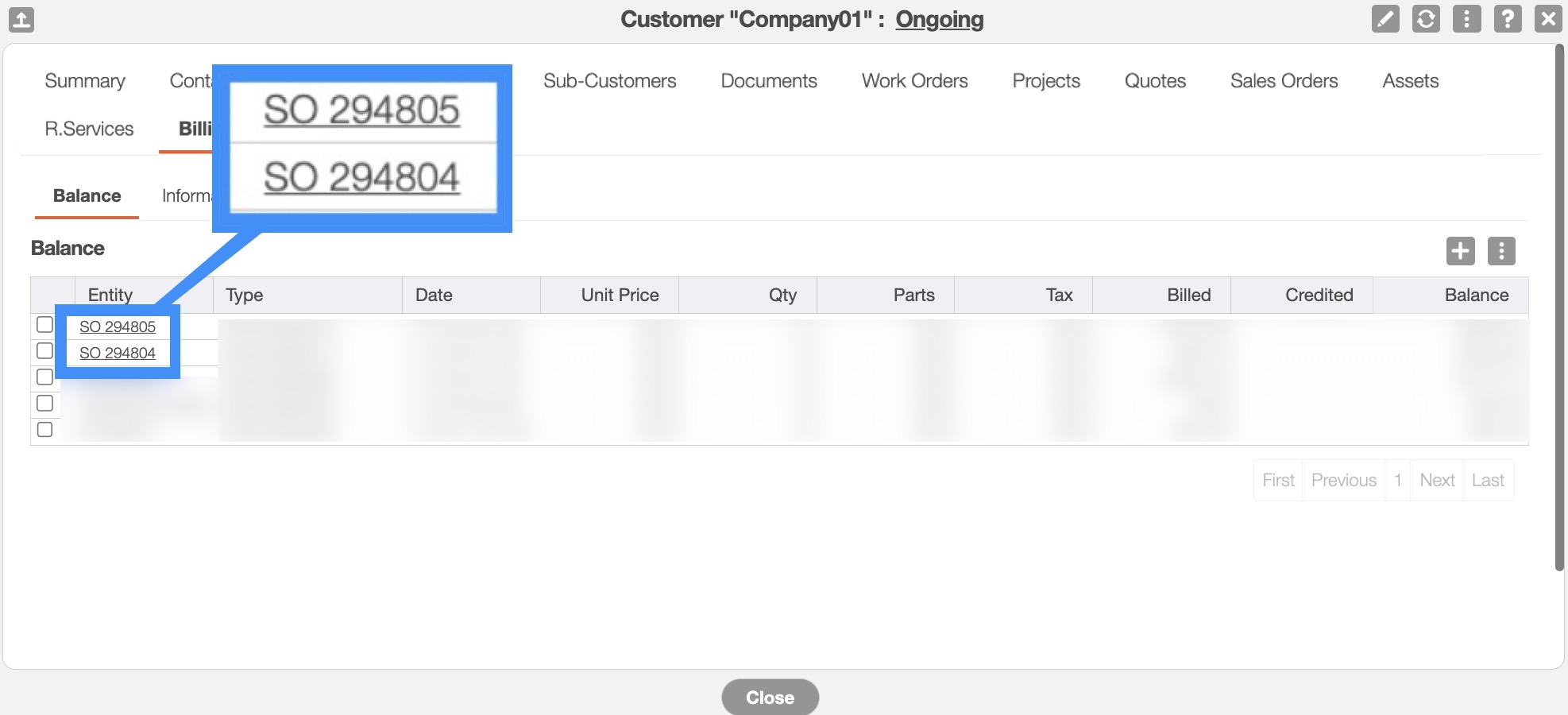
Note: Please note that the prefix SO signifies a Sales Order; if the billing item does not have a SO prefix in the "Entity" column then it is an invoice or quote.
Invoices
You can also access the View Sales Order pop-up window from the Invoices feature page or from the View Invoice pop-up window. For more information how to access these features please see the Invoices List page or the View an Invoice page.
Once you are on the Invoice "List" tab, you can click on the Sales Order number under the "Entity" column:

When you are in the View Invoice pop-up window, in the "Summary" box you can click on the Sales Order number:
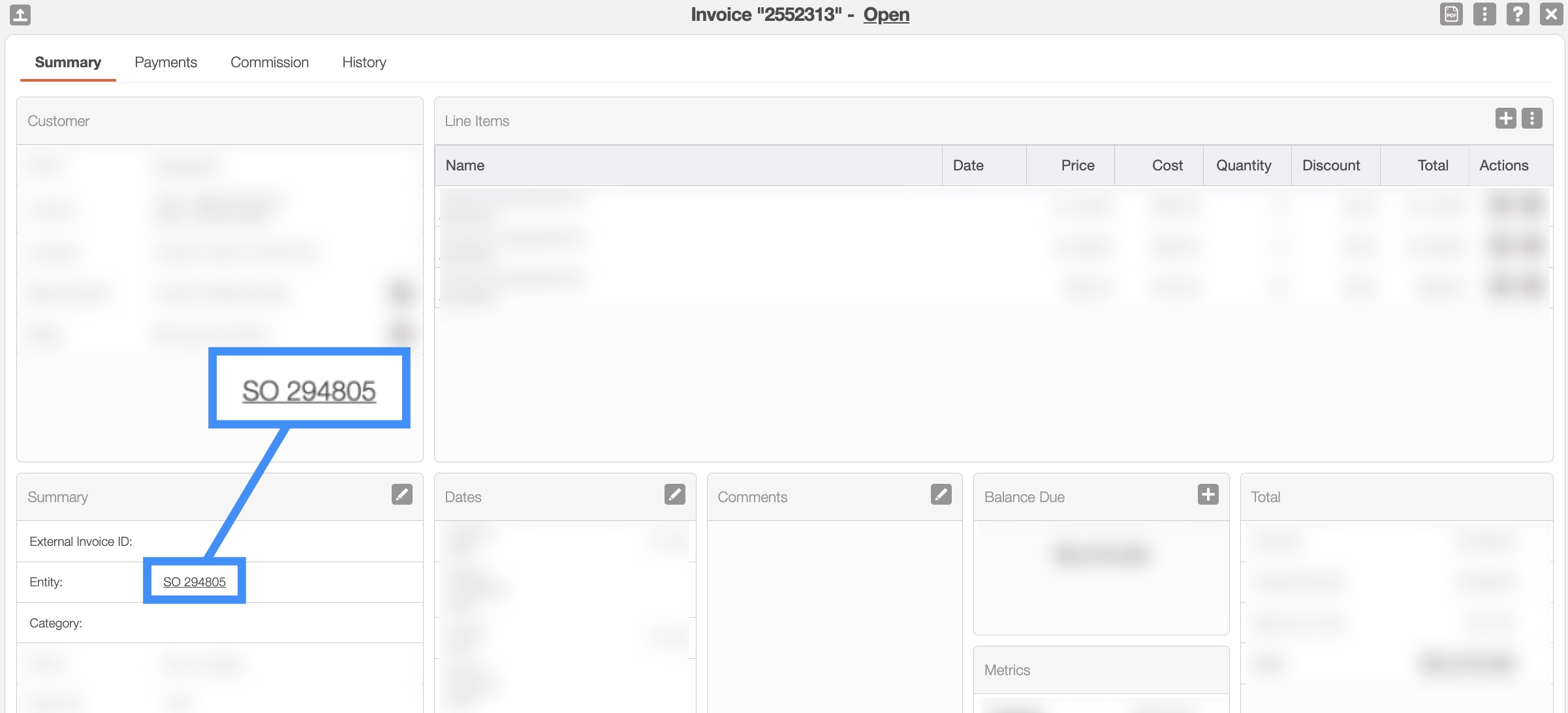
Note: Please note that the prefix SO signifies a Sales Order; if the billing item does not have a SO prefix in the "Entity" column then it is an invoice or quote.
Overview and Layout
Once you open the View Sales Order pop-up window, you will be automatically directed to the "Summary" tab:

These features are available in all five tabs and in both, the pop-up window and the full-size view:
Please note that if you would like to easily close this pop-up window, you can click on the esc button from your keyboard.
Sales Order Full-Size View
By clicking on the upwards arrow in the left-hand corner, you can expand the View Sales Order pop-up window so that it is full-size:

The full-size View Sales Order pop-up window can be seen below. All the tabs, buttons, and features are identical to how they would appear in the pop-up window:
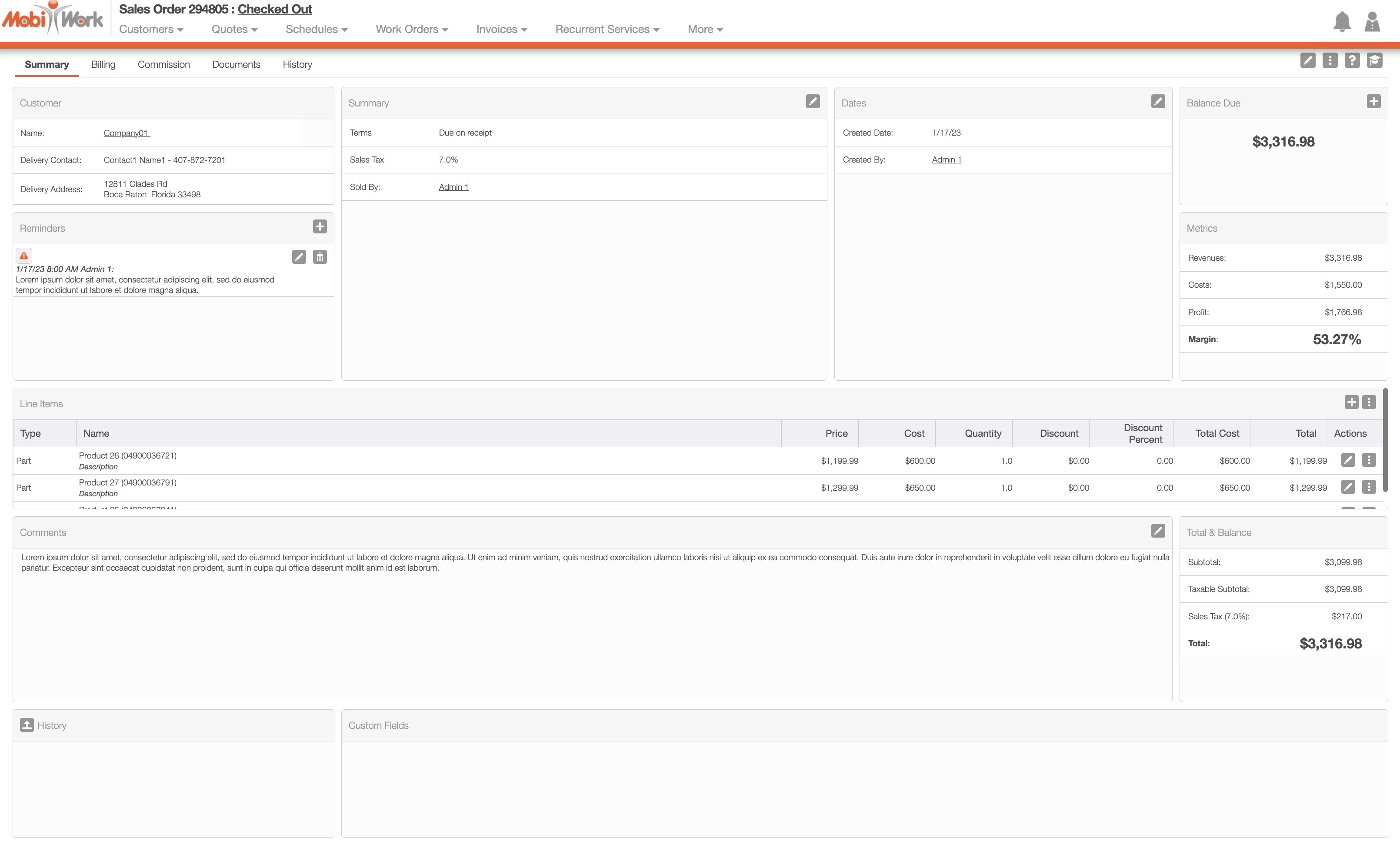
Sales Order Tabs
There are five tabs in all for the View Sales Order pop-up window; each tab displays different information regarding the sales order:

You can navigate to other tabs by clicking on the desired tab.
Sales Order ID and Status
The Sales Order ID and the status will be displayed towards the top of the View Sales Order pop-up window:
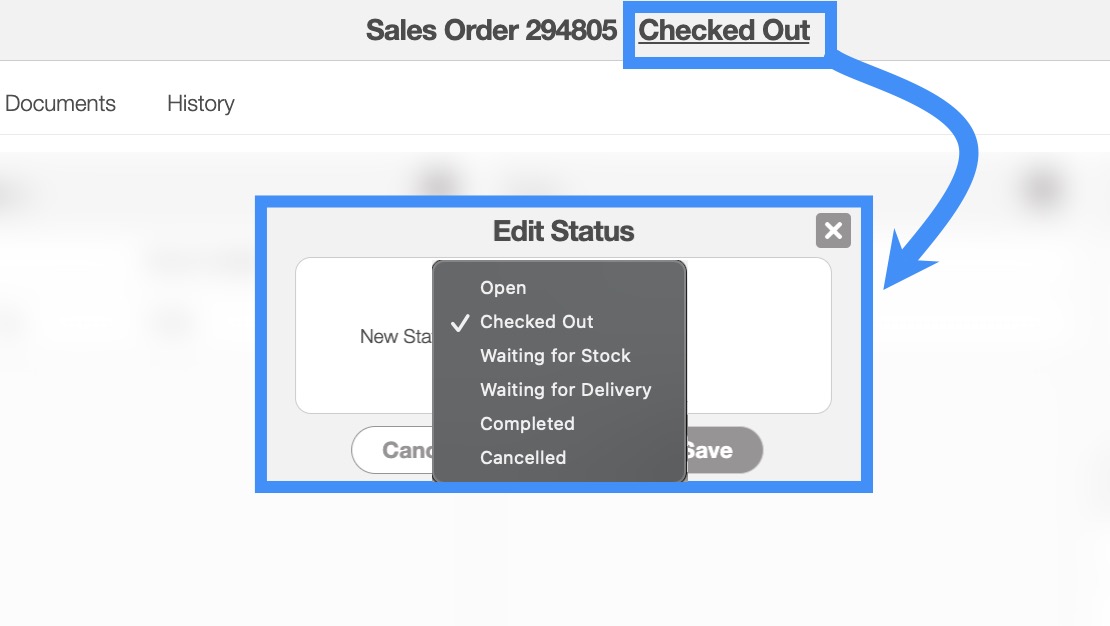
You can quickly change the status of the sales order by clicking on the status and selecting the desired new status.
The statuses that are available are:
Open
Checked Out
Waiting for Stock
Waiting for Delivery
Completed
Cancelled
Upper Right Corner Actions
In the upper right corner of the View Sales Order pop-up window there will be four buttons that will allow you to perform additional actions on the sales order:
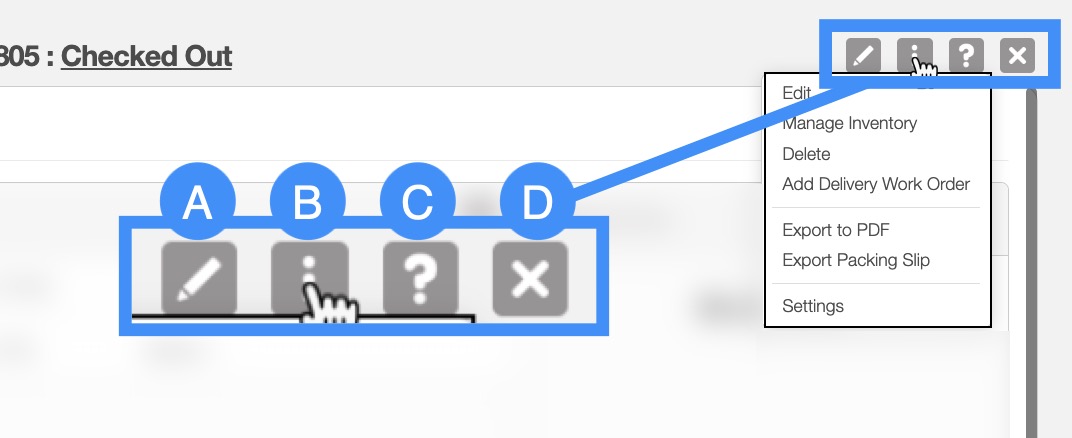
The Pencil button will allow you to edit the sales order.
The Individual Actions button will allow you to perform various actions, such as:
Editing the sales order
Managing the sales order inventory
Deleting the sales order
Adding a delivery work order
Exporting the sales order to PDF
Exporting the packing slip of the sales order
Accessing the Sales Order Settings page
The Question Mark button which will direct you to the respective MobiWork Features page.
The X will close out of the View Sales Order pop-up window.
The Sales Orders' Upper Right Corner Actions can be found in the top-right corner of the View Sales Order pop-up window. These actions are located in this section, regardless of the tab you are on:

The Upper Right Corner Actions section includes:
The Pencil button will allow you to edit the sales order.
The Individual Actions will allow you to perform various actions.
The Question Mark button which will direct you to the respective MobiWork Features page.
The X will close out of the View Sales Order pop-up window.
After clicking on the vertical three dots in the top-right corner, the Individual Actions drop-down menu will appear:

From the Individual Actions drop-down menu, you can select various actions that will help manage the specified sales order.
The complete list of actions found in the Individual Actions drop-down menu are defined below:
| Name: | Description: |
|---|---|
| "Edit" | Allows the user to edit the details of the sales order |
| "Manage Inventory" | Allows the user to manage the inventory quantity of the sales order |
| "Delete" | Allows the user to delete the sales order |
| "Add Delivery Work Order" | Allows the user to add a work order to the sales order |
| "Export to PDF" | Allows the user to export the sales order into a PDF document |
| "Export Packing Slip" | Allows the user to export the packing slip into a PDF document |
| "Settings" | Allows the user to access the Settings page |
The "Summary" tab is the default tab you will be directed to; it will display all the requisite information regarding a sales order.
The panels found on the "Summary" tab will summarize the data from the other View Sales Order tabs, including notes, sales tax, and more:
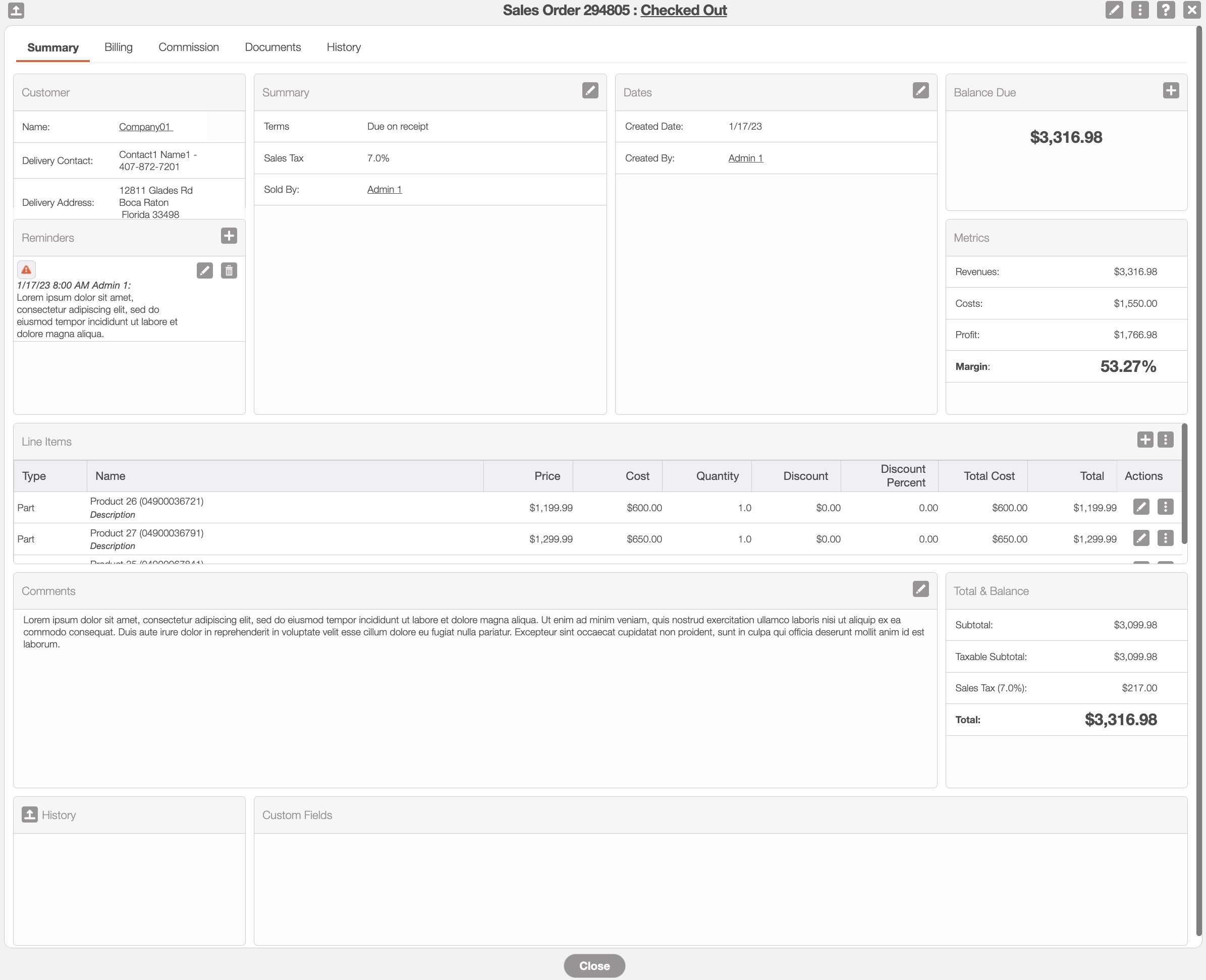
Where applicable, you can edit or add additional information directly in the "Summary" tab:
The Arrow icon (found in the top left of designated boxes) will open the corresponding tab in the View Sales Order pop-up window.
The Individual Actions button (the three dots) will display different options (e.g., view, edit, delete, etc.) depending on the corresponding panel.
The View icon will allow you to view the selected data in a separate window.
The Pencil icon will allow you to edit the selected data or field.
The Plus Sign icon will allow you to add additional reminders, notes, line items, etc.
The Trash Can icon will allow you to delete the selected data.
The "Billing" tab will display the invoice, amount billed to the customer, and the amount that the customer has paid towards the invoice, and the remaining balance:
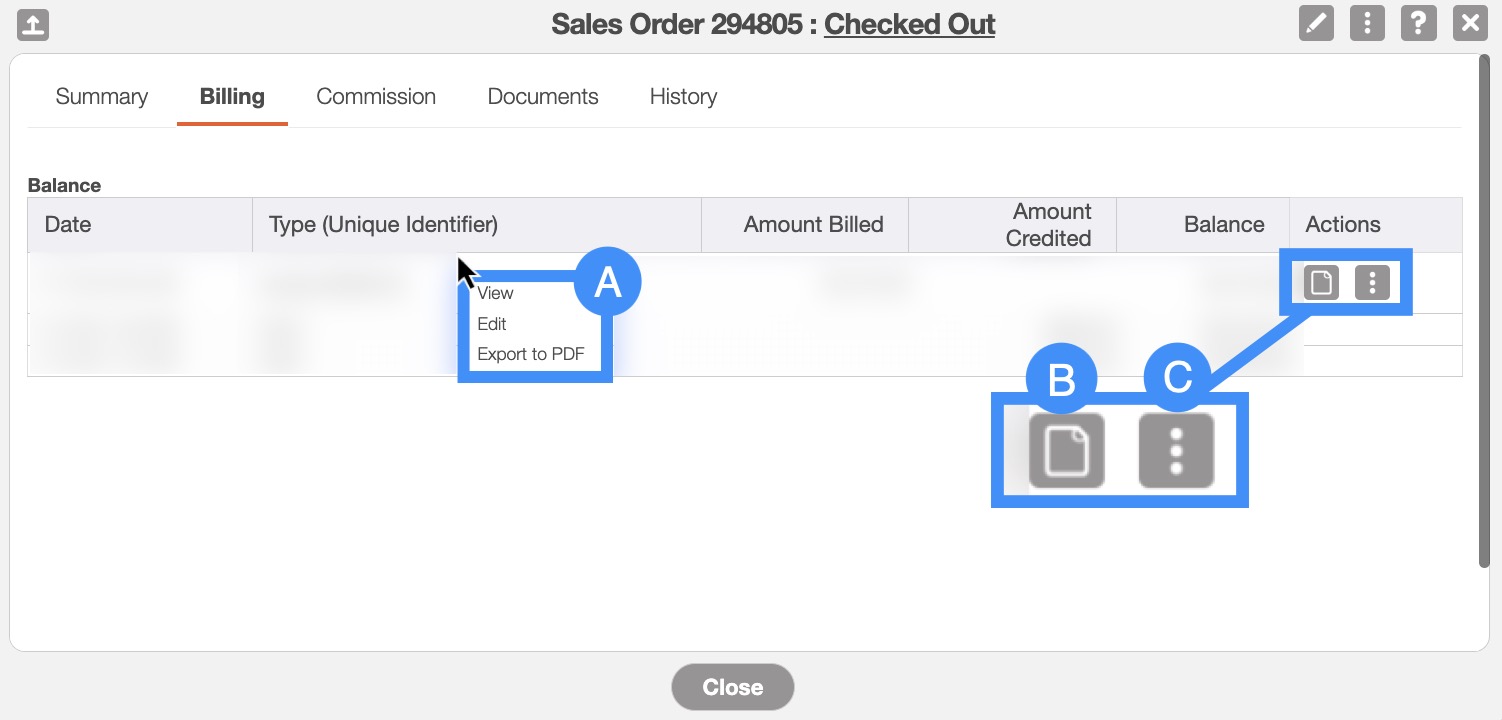
By right-clicking you will bring up the right-click actions. These actions are identical to the Individual Actions and will allow you to view, edit, or delete specified data.
The View icon will open the View Invoice pop-up window.
The Individual Actions (the three dots next to the View icon) are identical to the right-click actions and will allow you to view, edit, or delete the specified data.
The "Billing" tab has six columns which are defined below:
| Name: | Description: |
|---|---|
| "Date" | The date that the data (i.e., invoice or payment) was posted |
| "Type (Unique Identifier)" | The type of data being measured in the column (e.g., invoice, retainer, PayPal account, credit card [no process], cash, check, credit card, EFT, wire transfer, customer credit, voucher payment, or refund.) |
| Amount Billed | The amount invoiced to the customer for the sales order |
| Amount Credited | The amount paid by the customer for the sales order |
| "Balance" | The remaining balance pending on the sales order for the customer to pay |
| "Actions" | Allows you to view, edit, or export the invoice to PDF |
The "Commission" tab is the third tab located in the View Sales Order pop-up window. This tab displays the user who performed the sale, the type of commission they would receive, and the percentage of the commission.
You can add additional commissions or edit the commissions that are already on the sales order. There are two subsections in this tab: the "Commission" section, and the "Commission Amounts" section:
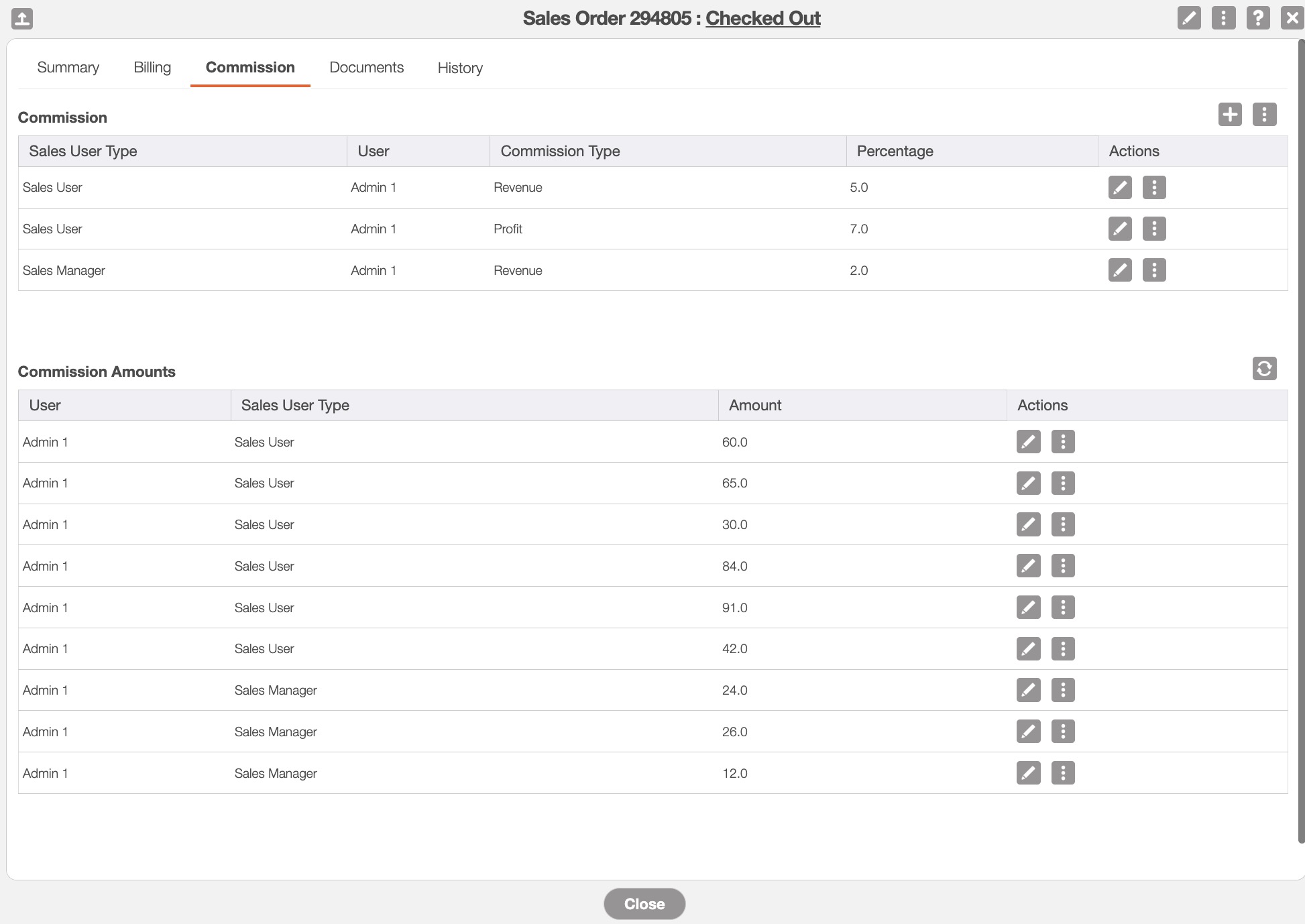
The columns for the "Commission" and" Commission Amounts" section are defined below:
| Name: | Description: |
|---|---|
| "Sales User Type" | If the user making the commission is a Sales User or a Sales Manager |
| "User" | The user who is receiving the commission |
| "Commission Type" | The type of commission earned (i.e., revenue or profit) |
| "Percentage" | The percentage amount earned of the commission |
| "Amount" | The amount earned of the commission |
| "Actions" | Allows you to edit or delete the commission. If you edit it in the Commission section you will be able to adjust the amount, type, and user. If you edit it in the Commission Amounts, you can adjust the amount |
Commission

- By right-clicking you will bring up the right-click actions. These actions are identical to the Individual Actions and will allow you to edit or delete the commission.
- The Pencil icon will allow you to edit the commission.
- The Individual Actions are identical to the right-click actions and will allow you to edit or delete the commission.
- The Plus Sign and the three vertical dots next to it, will allow you to add a new commission.
Commission Amounts
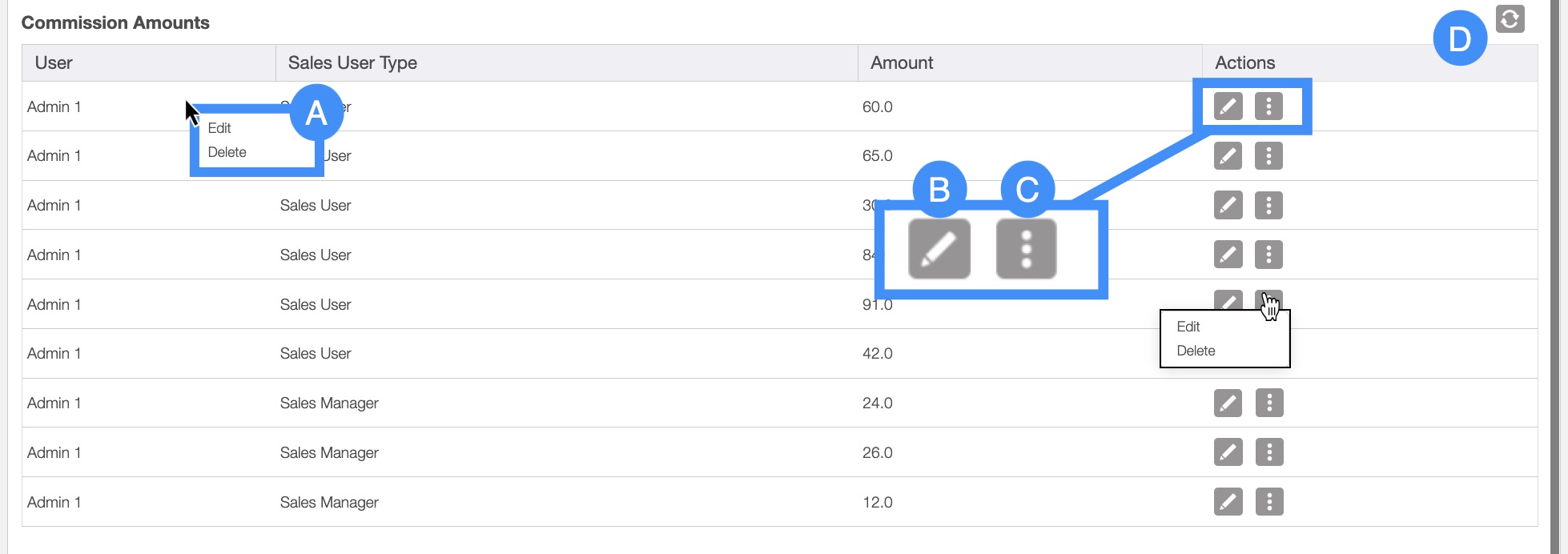
- By right-clicking you will bring up the right-click actions. These actions are identical to the Individual Actions and will allow you to edit the commission amount for the sales user or delete the commission.
- The Pencil icon will allow you to edit the commission amount for the sales user.
- The Individual Actions are identical to the right-click actions and will allow you to edit the commission amount for the sales user or delete the commission.
- The refresh button will refresh the data under "Commission Amounts" so that the information is up to date.
The "Documents" tab will allow you to store sales order-specific documentation (e.g., contracts, photos, etc.) for future use. This tab will also list the type of document file, the date it was uploaded, the user who uploaded it, and more.
To add a new document or file, you must click on the Plus Sign button and then drag & drop or choose a file to upload:

By right-clicking you will bring up the right-click actions. These actions are identical to the Individual Actions and will allow you to view, edit, download, or delete the document
The Plus Sign will add a new document or file
The topmost Individual Actions will allow you to add a new document or refresh the tab.
The View icon will allow you to view the image file in a new tab, window, or allow you to download the document.
The Individual Actions (the three dots next to the View icon) are identical to the right-click actions and will allow you to view, edit, download, or delete the document.
The terms for the "Documents" tab are defined below:
| Name: | Description: |
|---|---|
| "User" | The user who uploaded the document or file. |
| "Date" | The date that the document or image file was uploaded. |
| "Type" | The type of document (e.g., PDF, Word, image, Excel, etc.) |
| "Name" | The name of the document. |
| "Comment" | Any comments or notes associated with the document. |
| "Actions" | Allows you to view, edit, download, or delete the document. |
The "History" tab is the fifth tab located in the View Sales Order pop-up window. It will display the historical data of the sales order:

The terms found in this tab are defined below:
| Name: | Description: |
|---|---|
| "Date" | The date of the activity |
| "Activity Type" | The activity typ. |
| "Description" | The description of the activity. |
| "User" | The user who performed the activity |
| "Refresh" | Will allow the user to refresh the information in "History" tab |
If you have any questions or need further assistance, please let us know. We'd be happy to help!
